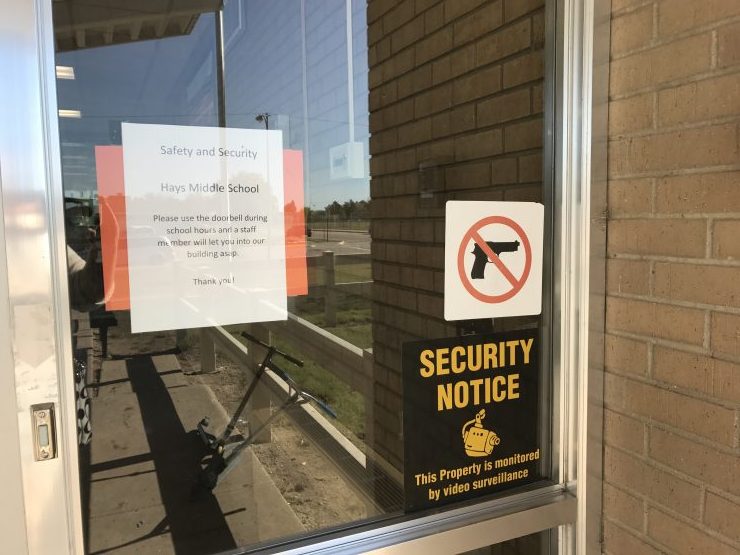By CRISTINA JANNEY
Hays Post

Hays USD 489 is looking at improving security at its schools as it forms a plan on a new bond issue.
An evaluation by the district’s architect, DLR Group, indicated all the district’s schools had security concerns. Specifically, those concerns revolved around controlled access and line of sight to the front doors to the buildings.
Amber Beverlin, senior architect for DLR, said during the facility analysis, the firm assessed security of the perimeters of the buildings and the main entries. The firm considered how visitors enter a facility and how far they can travel inside the building before encountering a staff member. It also looked at the amount of and use of technology to monitor people entering and exiting buildings.
All of the buildings have a new ID system that was upgraded with a grant this school year. Signs at the buildings direct visitors to the buildings’ offices. There, staff members can scan visitors’ driver’s licenses. Software then checks them against a KBI database.
Visitors are given ID badges to wear while they are in the buildings and are instructed to check out as they leave the buildings.
However, Superintendent John Thissen admitted there are flaws in the system.
Only two of the district’s six K-12 buildings lock all doors during the school days, which means someone with ill intent could enter the other schools and conceivably make it well into the buildings before they were noticed.
When DLR did its review, it pointed out most of the schools’ office staff have poor line of sight to the front door of their buildings. Only Wilson Elementary has an office with windows that faces the front door.
Beverlin said, as school districts across the nation remodel and construct new buildings, they are creating “pinch points,” so visitors to the buildings can be better monitored.

“Good sight lines from the administration office to the entry provides a second layer of security to monitor people entering and exiting the building,” she said. “In addition, exit doors around the perimeter of the building should have the ability to be electronically locked/unlocked or monitored.”
Thissen said the line of sight is especially bad at Lincoln Elementary because of the placement of the office and its distance from the front entrance.
All the schools in the district have security cameras, which include coverage of the schools’ front doors.
Lincoln Principal Elaine Rohleder’s office has a security camera feed, but she admitted she and the staff can’t watch the feeds every minute of the school day.
The middle school went to a policy of locking all entrances within the last two years and O’Loughlin just made the change within the last few weeks. Visitors to these schools ring a doorbell and wait for a staff member to let them into the building.
Vicki Gile, O’Loughlin principal, said the change in policy would give the staff time to call 911 if they perceive someone who might be a threat trying to enter the building.
“For me, my vision is that it is going to buy us time,” Gile said.
Although cases of active shooters in schools have received much attention in the media, Wilson Principal Anita Scheve noted school violence is more likely to be perpetrated by someone who has a connection with the school. This could include issues with non-custodial parents.
Scheve noted teachers and staff try to build good relationships with children and families in attempts to address issues at home before they might spill over into an issue at school.
“Teachers have relationships with parents and students to know when things are unsettled at home,” she said. “They are aware when kids are struggling or parents are struggling. They have awareness of behavior that something might get out of hand. Families can be referred to mental health, family preservation or DCF.”
Training and education has also become an essential piece of the security net for all USD 489 schools.
Where once students and staff only practiced fire and tornado drills, today students have intruder and evacuation drills.
Thissen said in the district’s crisis plan, officials have looked at many different threat scenarios. An intruder might not be the most likely threat to students’ safety. An anhydrous ammonia leak from a passing semi truck may be more likely.
No matter what the threat, Thissen said it falls to the district to be prepared.
“Hays is a safe place. It is now and it will continue to be a safe place,” he said. “However, for us to not plan for and be prepared for such a situation would be irresponsible.”
Goddard schools recently passed a $52 million bond issue that addressed maintenance needs, but also safety and security issues. The district will place intruder locks on all the schools’ classrooms and build multi-use storm shelters.
Dane Baxa, Goddard director of community relations, said improving safety and security was a key element in selling the bond issue to the public.
“When you tell moms that you can make schools safer if there is an intruder or active shooter if classrooms can be locked more quickly, everyone wants those improvements made,” he said.
Thissen said upgrading locks on buildings could also be an element of the bond.
As USD 489’s bond issue committee starts to put dollars to possible projects, the cost of improving line of sight to entrances and putting in place other security measures will become more apparent.
The issue is not whether the community wants to make schools safer — it is an issue of cost, Thissen said.
“People are not going to get in the way of safety. No one is going to say, ‘You are making the schools too safe,’ ” he said. “It is how much money it’s going to cost to do that.”
The next meeting of the bond committee is Tuesday.
